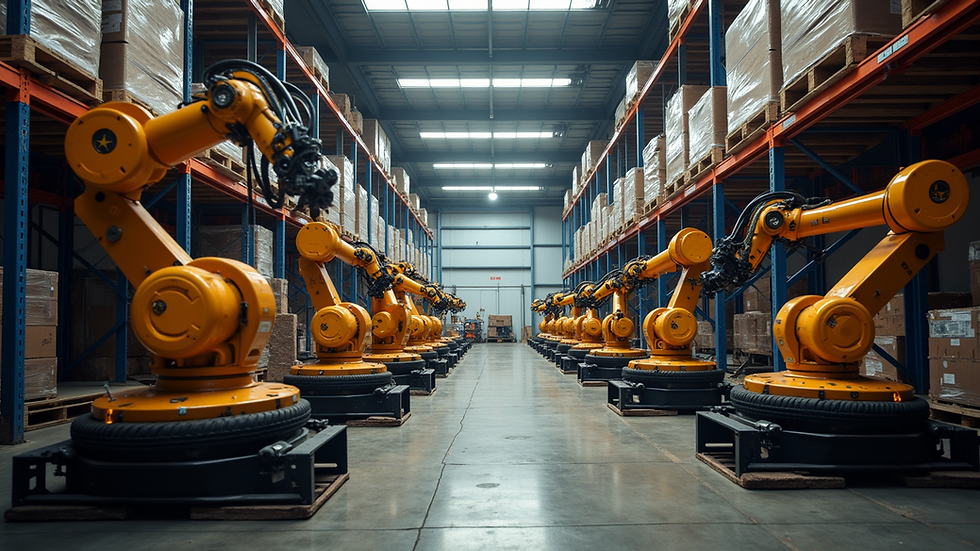Why AI is Revolutionizing Business Today
- Trent Creal

- Sep 2
- 3 min read
Artificial intelligence is no longer a futuristic concept. It’s here, and it’s reshaping how you run your business. Whether you manage supply chains, lead operations, or build a startup, AI is the tool that can cut inefficiencies, automate workflows, and unlock new growth. This is not about hype or theory. It’s about practical, tactical moves that deliver measurable results.
Business Innovations with AI: What You Need to Know
You’re facing pressure to scale with lean teams. Outdated workflows slow you down. You need to prove ROI on every investment. AI is the game-changer that meets these demands head-on. It’s not just about automation; it’s about smart automation that learns, adapts, and optimizes your processes.
Take supply chain management, for example. AI-powered predictive analytics can forecast demand with precision, reducing inventory costs and avoiding stockouts. In manufacturing, AI-driven quality control systems catch defects faster than any human inspector. For entrepreneurs, AI tools automate content creation, freeing up time to focus on growth and brand building.
The key is integration. AI works best when embedded into your existing systems, enhancing—not replacing—your current operations. You don’t need to overhaul everything overnight. Start small, measure impact, and scale what works.

What is AI Used for in Business?
AI’s applications are vast, but here are the core areas where it delivers the most value:
Process Automation
Automate repetitive tasks like data entry, invoicing, and customer support. This reduces errors and frees your team for higher-value work.
Predictive Analytics
Use AI to analyze historical data and predict trends. This helps in demand forecasting, maintenance scheduling, and risk management.
Customer Insights
AI analyzes customer behavior to personalize marketing, improve service, and increase retention.
Supply Chain Optimization
AI optimizes routes, manages inventory, and predicts disruptions before they happen.
Product Development
Accelerate R&D by simulating scenarios and analyzing market feedback faster.
Content Automation
For content creators and niche experts, AI tools generate blogs, videos, and social media posts, scaling output without sacrificing quality.
Each of these uses translates into tangible benefits: cost savings, faster decision-making, improved quality, and better customer experiences.

How to Implement AI Without Overwhelm
You don’t have to be an AI expert to start. The best approach is tactical and incremental:
Identify Pain Points
Pinpoint where inefficiencies hit hardest. Is it inventory management? Customer service? Content creation?
Choose the Right Tools
Look for AI solutions tailored to your industry and scale. Many platforms offer plug-and-play options with minimal setup.
Train Your Team
Invest in upskilling so your people understand AI’s role and can leverage it effectively.
Measure and Iterate
Track KPIs closely. If a tool isn’t delivering, pivot quickly.
Integrate Gradually
Start with one process, prove ROI, then expand.
Remember, AI is a tool to amplify your expertise, not replace it. The goal is to work smarter, not harder.
Real-World Examples of AI Driving Results
Automotive Manufacturing
A plant manager uses AI-powered predictive maintenance to reduce downtime by 30%. Sensors detect equipment wear before failure, scheduling repairs proactively.
Outdoor Gear Retailer
An entrepreneur automates product descriptions and social media posts using AI, doubling content output while cutting marketing costs.
Medical Device Supply Chain
Procurement leads leverage AI to forecast demand spikes, avoiding costly shortages during critical periods.
Content Creator in Motorsports
AI tools automate video editing and transcription, freeing up time to focus on storytelling and audience engagement.
These examples show AI’s versatility across industries and roles. The common thread is clear: AI delivers operational efficiency and competitive advantage.

Your Next Steps to Harness AI Power
You’re ready to move beyond buzzwords and start building with AI. Here’s your action plan:
Assess Your Current Operations
Map out workflows and identify bottlenecks ripe for AI intervention.
Explore AI Solutions
Research platforms that fit your scale and industry. Consider consulting experts who understand both AI and your business domain.
Pilot a Project
Choose a low-risk area to implement AI. Set clear goals and metrics.
Build Internal Buy-In
Communicate benefits and involve your team early to reduce resistance.
Scale Smartly
Use data from your pilot to refine and expand AI use.
Stay Updated
AI evolves fast. Keep learning and adapting to new tools and techniques.
For a deeper dive into how ai in business is transforming operations and entrepreneurship, explore resources that blend enterprise solutions with lifestyle and automation tools. This integrated approach ensures you’re not just adopting AI but thriving with it.
AI is not a luxury or a future promise. It’s a practical, tactical advantage you can deploy today. Cut the noise, focus on what moves the needle, and build your business innovations with AI that deliver real-world results. The trail is open - it’s time to ride it.











Comments